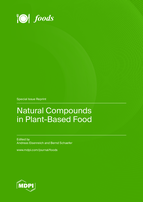Natural Compounds in Plant-Based Food
A special issue of Foods (ISSN 2304-8158). This special issue belongs to the section "Nutraceuticals, Functional Foods, and Novel Foods".
Deadline for manuscript submissions: closed (10 July 2022) | Viewed by 65615
Special Issue Editors
Interests: food toxicology; clinical pharmacology; pharmacology; cardiorenal biology; genetics
Special Issue Information
Dear Colleagues,
Culinary herbs or spices confer characteristic flavor or coloring to food. In this Special Issue of Foods, we want to shed more light on culinary herbs and spices from a health perspective. Substances of plant origin are often regarded as harmless per se. The intention here is to give a science-based view on the health impact of ingredients occurring naturally in plants with a special focus on those present in plants used as culinary herbs and spices. In this context, different aspects will be addressed, including toxicological, analytical, and regulatory issues regarding naturally occurring ingredients in culinary herbs and spices as well as in products, such as essential oils, and food supplements based on them. For this purpose, some selected examples of these compounds will be utilized to illustrate potential effects on human health, together with knowledge gaps related to hazard and exposure assessment. Moreover, safety issues related to products, such as essential oils, or food supplements containing extracts of culinary herbs and spices that have become widely available to consumers through several distribution channels in the EU, will be covered.
Prof. Dr. Andreas Eisenreich
Prof. Dr. Bernd Schaefer
Guest Editors
Manuscript Submission Information
Manuscripts should be submitted online at www.mdpi.com by registering and logging in to this website. Once you are registered, click here to go to the submission form. Manuscripts can be submitted until the deadline. All submissions that pass pre-check are peer-reviewed. Accepted papers will be published continuously in the journal (as soon as accepted) and will be listed together on the special issue website. Research articles, review articles as well as short communications are invited. For planned papers, a title and short abstract (about 100 words) can be sent to the Editorial Office for announcement on this website.
Submitted manuscripts should not have been published previously, nor be under consideration for publication elsewhere (except conference proceedings papers). All manuscripts are thoroughly refereed through a single-blind peer-review process. A guide for authors and other relevant information for submission of manuscripts is available on the Instructions for Authors page. Foods is an international peer-reviewed open access semimonthly journal published by MDPI.
Please visit the Instructions for Authors page before submitting a manuscript. The Article Processing Charge (APC) for publication in this open access journal is 2900 CHF (Swiss Francs). Submitted papers should be well formatted and use good English. Authors may use MDPI's English editing service prior to publication or during author revisions.
Keywords
- Culinary herbs or spices
- Food flavor or food coloring
- Health perspective
- Plant origin
- Health ingredients
- Analytical and regulatory issues
- Essential oils
- Food supplements
- Food safety







